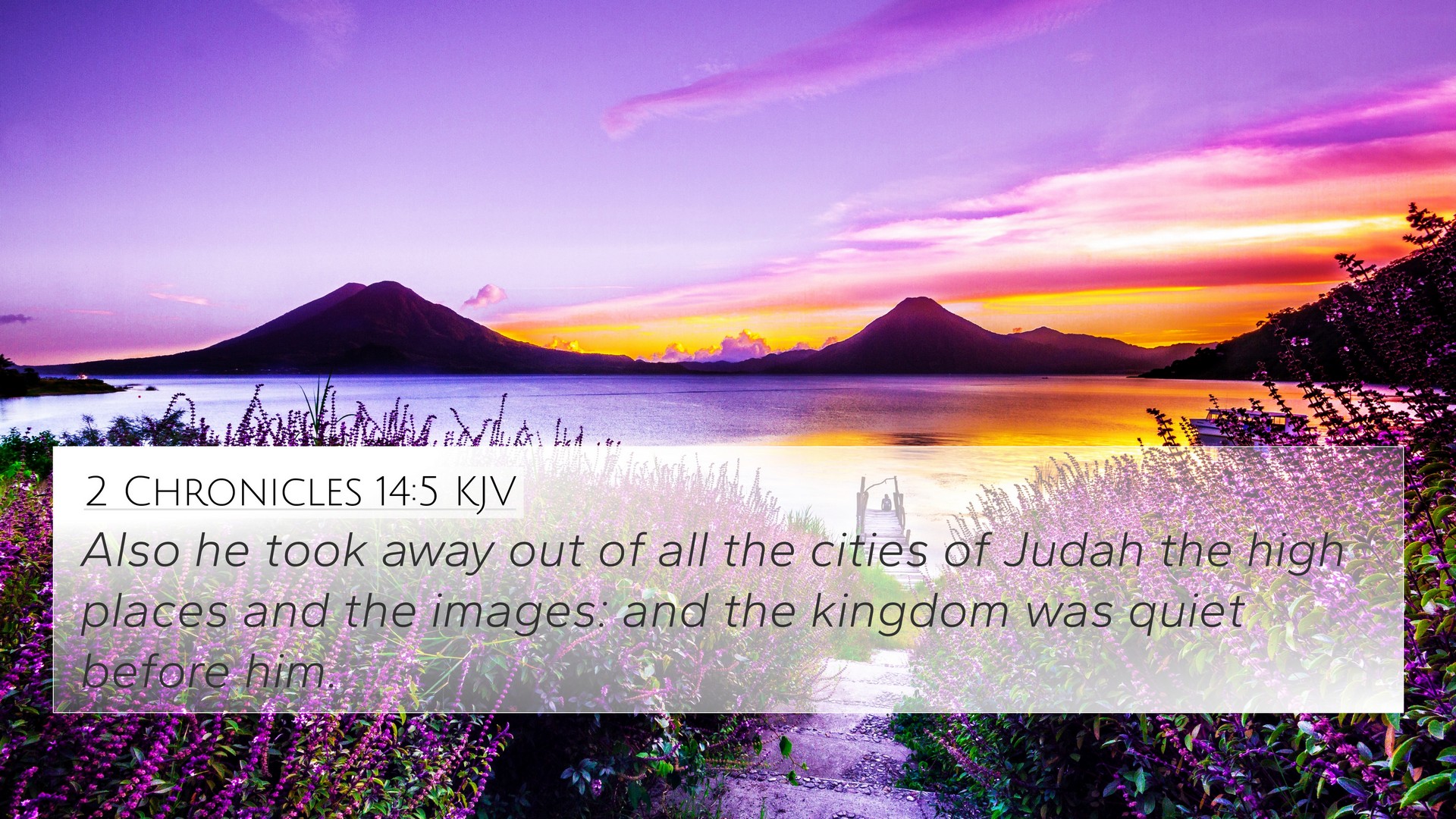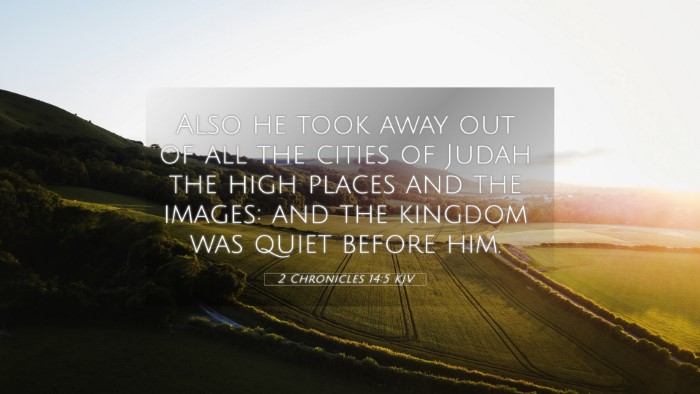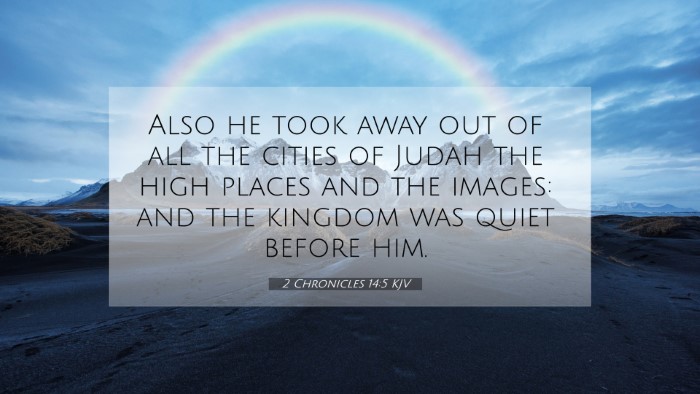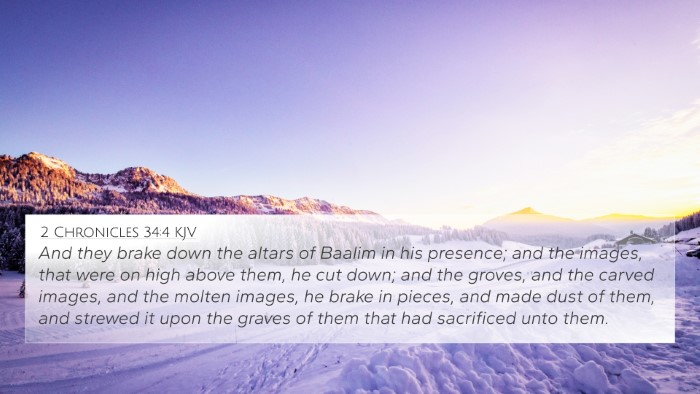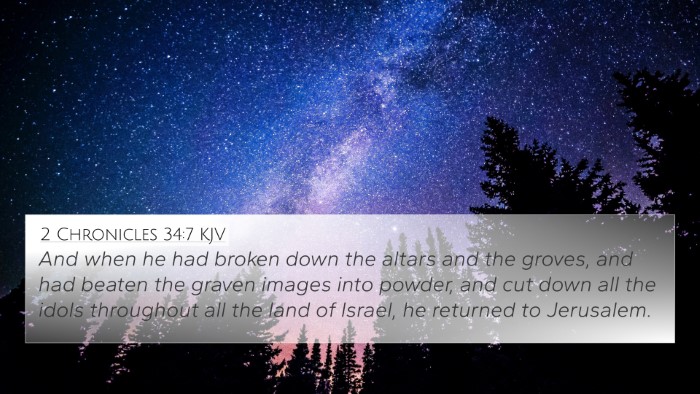2 Chronicles 14:5 Meaning and Interpretation
In this verse, we see a significant moment in the reign of King Asa of Judah. The text states, “And he took away the altars of the strange gods, and the high places, and broke down the images, and cut down the groves.” This action demonstrates Asa's commitment to purifying the worship practices of Judah, aligning them with the worship of the one true God. The efforts to eliminate idolatry are paramount in a biblical context, as they revealed Asa's desires to reform and return the people to pure worship.
Historical Context
Asa was the third king of Judah after the division of the kingdom. Unlike some of his predecessors, who indulged in idol worship, Asa initiated important reforms aimed at restoring true worship of Yahweh. Public domain commentaries such as Matthew Henry emphasize the importance of these reforms as a means to re-establish covenant fidelity among the people of Judah.
Thematic Insights
Asa's actions serve to highlight several themes present throughout Scripture:
- Idolatry vs. True Worship: Asa stands as a figure representing the rejection of idol worship in favor of reverence towards God.
- Leadership and Reform: The role of a king in influencing the spiritual direction of a nation is crucial, as seen in Asa's commitment.
- God’s Covenant: This passage signifies a return to covenant loyalty as fundamental in the maintenance of God's blessings.
Bible Verse Cross-References
Here are some Bible verses that relate and provide a deeper understanding of Asa's actions in the broader inter-Biblical dialogue:
- Exodus 20:4-5 - This passage warns against the making of idols, establishing the foundation for Asa's reforms.
- Deuteronomy 12:2-3 - Instructions for breaking down places of idol worship mirror Asa's reformist zeal.
- 1 Kings 15:14 - A comparison passage highlighting Asa's rejection of high places, akin to his proactive measures in 2 Chronicles 14:5.
- 2 Chronicles 15:8 - Further details on Asa's actions that were part of his commitment to righteousness.
- 2 Kings 18:4 - Similar reforms undertaken by King Hezekiah, illustrating a pattern in Judah's history of returning to right worship.
- Psalm 106:34-39 - A reflection on Israel's repeated offenses through idolatry and the resulting consequences.
- Isaiah 44:9-20 - A passage mocking idol worship that emphasizes the futility Asa sought to eliminate.
Connecting several biblical themes
Asa’s desire to cleanse the land of idolatry connects with a larger biblical narrative centered around covenant faithfulness and the call to purity in worship. For instance, the thematic connections between Asa’s reforms and other scriptural calls to repentance underscore a foundational tenet of Biblical theology—the priority of worshiping God alone.
The parallels between Asa's actions and New Testament teachings also highlight the implications of idolatry, as New Testament scriptures also warn against placing anything above the genuine worship of Christ (see Colossians 3:5 and 1 John 5:21).
Applications for Today
The call to remove sources of idolatry and distractions from worship echoes with modern Christian practice. Believers can reflect on what 'altars of strange gods' might look like in their lives today, whether they manifest through materialism, self-worship, or other distractions that lead one away from a direct relationship with God.
Conclusion
2 Chronicles 14:5 is not merely a historical recount of Asa’s reforms but integrates within a broader theological framework that emphasizes worship's purity, the covenant relationship with God, and calls for transformative repentance. As we study connects through a Bible cross-reference guide, we see that understanding Scripture in light of its interwoven themes enriches our faith journey.
